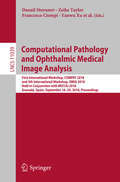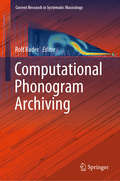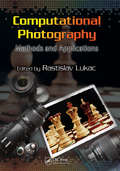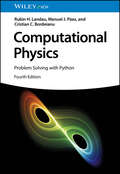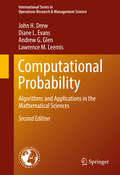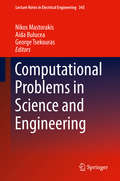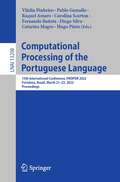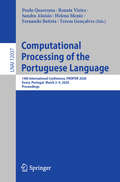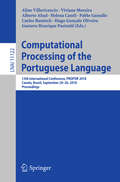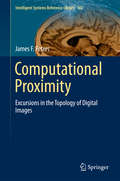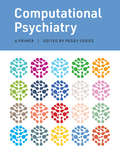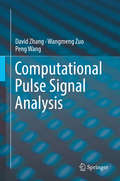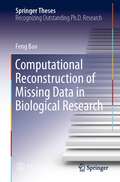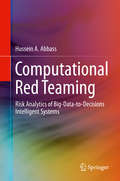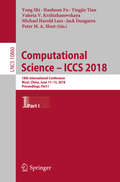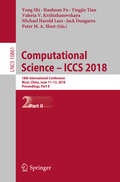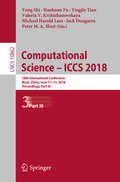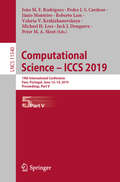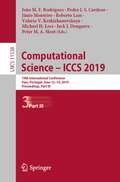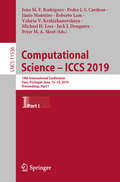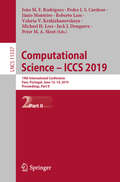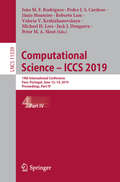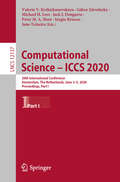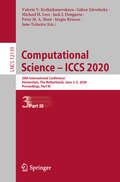- Table View
- List View
Computational Pathology and Ophthalmic Medical Image Analysis: First International Workshop, COMPAY 2018, and 5th International Workshop, OMIA 2018, Held in Conjunction with MICCAI 2018, Granada, Spain, September 16 - 20, 2018, Proceedings (Lecture Notes in Computer Science #11039)
by Danail Stoyanov Zeike Taylor Francesco Ciompi Yanwu Xu Anne Martel Lena Maier-Hein Nasir Rajpoot Jeroen van der Laak Mitko Veta Stephen McKenna David Snead Emanuele Trucco Mona K. Garvin Xin Jan Chen Hrvoje BogunovicThis book constitutes the refereed joint proceedings of the First International Workshop on Computational Pathology, COMPAY 2018, and the 5th International Workshop on Ophthalmic Medical Image Analysis, OMIA 2018, held in conjunction with the 21st International Conference on Medical Imaging and Computer-Assisted Intervention, MICCAI 2018, in Granada, Spain, in September 2018. The 19 full papers (out of 25 submissions) presented at COMPAY 2018 and the 21 full papers (out of 31 submissions) presented at OMIA 2018 were carefully reviewed and selected. The COMPAY papers focus on artificial intelligence and deep learning. The OMIA papers cover various topics in the field of ophthalmic image analysis.
Computational Phonogram Archiving (Current Research in Systematic Musicology #5)
by Rolf BaderThe future of music archiving and search engines lies in deep learning and big data. Music information retrieval algorithms automatically analyze musical features like timbre, melody, rhythm or musical form, and artificial intelligence then sorts and relates these features. At the first International Symposium on Computational Ethnomusicological Archiving held on November 9 to 11, 2017 at the Institute of Systematic Musicology in Hamburg, Germany, a new Computational Phonogram Archiving standard was discussed as an interdisciplinary approach. Ethnomusicologists, music and computer scientists, systematic musicologists as well as music archivists, composers and musicians presented tools, methods and platforms and shared fieldwork and archiving experiences in the fields of musical acoustics, informatics, music theory as well as on music storage, reproduction and metadata. The Computational Phonogram Archiving standard is also in high demand in the music market as a search engine for music consumers. This book offers a comprehensive overview of the field written by leading researchers around the globe.
Computational Photography: Methods and Applications (Digital Imaging and Computer Vision)
by Rastislav LukacComputational photography refers broadly to imaging techniques that enhance or extend the capabilities of digital photography. This new and rapidly developing research field has evolved from computer vision, image processing, computer graphics and applied optics—and numerous commercial products capitalizing on its principles have already appeared in diverse market applications, due to the gradual migration of computational algorithms from computers to imaging devices and software. Computational Photography: Methods and Applications provides a strong, fundamental understanding of theory and methods, and a foundation upon which to build solutions for many of today's most interesting and challenging computational imaging problems. Elucidating cutting-edge advances and applications in digital imaging, camera image processing, and computational photography, with a focus on related research challenges, this book: Describes single capture image fusion technology for consumer digital cameras Discusses the steps in a camera image processing pipeline, such as visual data compression, color correction and enhancement, denoising, demosaicking, super-resolution reconstruction, deblurring, and high dynamic range imaging Covers shadow detection for surveillance applications, camera-driven document rectification, bilateral filtering and its applications, and painterly rendering of digital images Presents machine-learning methods for automatic image colorization and digital face beautification Explores light field acquisition and processing, space-time light field rendering, and dynamic view synthesis with an array of cameras Because of the urgent challenges associated with emerging digital camera applications, image processing methods for computational photography are of paramount importance to research and development in the imaging community. Presenting the work of leading experts, and edited by a renowned authority in digital color imaging and camera image processing, this book considers the rapid developments in this area and addresses very particular research and application problems. It is ideal as a stand-alone professional reference for design and implementation of digital image and video processing tasks, and it can also be used to support graduate courses in computer vision, digital imaging, visual data processing, and computer graphics, among others.
Computational Photonics: An Introduction with MATLAB
by Marek S. WartakA comprehensive manual on the efficient modeling and analysis of photonic devices through building numerical codes, this book provides graduate students and researchers with the theoretical background and MATLAB programs necessary for them to start their own numerical experiments. Beginning by summarizing topics in optics and electromagnetism, the book discusses optical planar waveguides, linear optical fiber, the propagation of linear pulses, laser diodes, optical amplifiers, optical receivers, finite-difference time-domain method, beam propagation method and some wavelength division devices, solitons, solar cells and metamaterials. Assuming only a basic knowledge of physics and numerical methods, the book is ideal for engineers, physicists and practising scientists. It concentrates on the operating principles of optical devices, as well as the models and numerical methods used to describe them.
Computational Physics: Problem Solving with Python
by Rubin H. Landau Manuel J. Páez Cristian C. BordeianuComputational Physics The classic in the field for more than 25 years, now with increased emphasis on data science and new chapters on quantum computing, machine learning (AI), and general relativity Computational physics combines physics, applied mathematics, and computer science in a cutting-edge multidisciplinary approach to solving realistic physical problems. It has become integral to modern physics research because of its capacity to bridge the gap between mathematical theory and real-world system behavior. Computational Physics provides the reader with the essential knowledge to understand computational tools and mathematical methods well enough to be successful. Its philosophy is rooted in “learning by doing”, assisted by many sample programs in the popular Python programming language. The first third of the book lays the fundamentals of scientific computing, including programming basics, stable algorithms for differentiation and integration, and matrix computing. The latter two-thirds of the textbook cover more advanced topics such linear and nonlinear differential equations, chaos and fractals, Fourier analysis, nonlinear dynamics, and finite difference and finite elements methods. A particular focus in on the applications of these methods for solving realistic physical problems. Readers of the fourth edition of Computational Physics will also find: An exceptionally broad range of topics, from simple matrix manipulations to intricate computations in nonlinear dynamicsA whole suite of supplementary material: Python programs, Jupyter notebooks and videos Computational Physics is ideal for students in physics, engineering, materials science, and any subjects drawing on applied physics.
Computational Probability: Algorithms and Applications in the Mathematical Sciences (International Series in Operations Research & Management Science #246)
by Andrew G. Glen Lawrence M. Leemis John H. Drew Diane L. EvansThis new edition includes the latest advances and developments in computational probability involving A Probability Programming Language (APPL). The book examines and presents, in a systematic manner, computational probability methods that encompass data structures and algorithms. The developed techniques address problems that require exact probability calculations, many of which have been considered intractable in the past. The book addresses the plight of the probabilist by providing algorithms to perform calculations associated with random variables. Computational Probability: Algorithms and Applications in the Mathematical Sciences, 2nd Edition begins with an introductory chapter that contains short examples involving the elementary use of APPL. Chapter 2 reviews the Maple data structures and functions necessary to implement APPL. This is followed by a discussion of the development of the data structures and algorithms (Chapters 3-6 for continuous random variables and Chapters 7-9 for discrete random variables) used in APPL. The book concludes with Chapters 10-15 introducing a sampling of various applications in the mathematical sciences. This book should appeal to researchers in the mathematical sciences with an interest in applied probability and instructors using the book for a special topics course in computational probability taught in a mathematics, statistics, operations research, management science, or industrial engineering department.
Computational Problems in Science and Engineering (Lecture Notes in Electrical Engineering #343)
by Nikos Mastorakis Aida Bulucea George TsekourasThis book provides readers with modern computational techniques for solving variety of problems from electrical, mechanical, civil and chemical engineering. Mathematical methods are presented in a unified manner, so they can be applied consistently to problems in applied electromagnetics, strength of materials, fluid mechanics, heat and mass transfer, environmental engineering, biomedical engineering, signal processing, automatic control and more.
Computational Processing of the Portuguese Language: 15th International Conference, PROPOR 2022, Fortaleza, Brazil, March 21–23, 2022, Proceedings (Lecture Notes in Computer Science #13208)
by Vládia Pinheiro Pablo Gamallo Raquel Amaro Carolina Scarton Fernando Batista Diego Silva Catarina Magro Hugo PintoThis book constitutes the proceedings of the 15th International Conference on Computational Processing of the Portuguese Language, PROPOR 2021, held in Fortaleza, Brazil, in March 2021. The 36 full papers presented together with 4 short papers were carefully reviewed and selected from 88 submissions. They are grouped in topical sections on speech processing; resources and evaluation; natural language processing applications; semantics; natural language processing tasks; and multilinguality.
Computational Processing of the Portuguese Language: 14th International Conference, PROPOR 2020, Evora, Portugal, March 2–4, 2020, Proceedings (Lecture Notes in Computer Science #12037)
by Paulo Quaresma Teresa Gonçalves Fernando Batista Renata Vieira Sandra Aluísio Helena MonizThis book constitutes the proceedings of the 14th International Conference on Computational Processing of the Portuguese Language, PROPOR 2020, held in Evora, Portugal, in March 2020. The 36 full papers presented together with 5 short papers were carefully reviewed and selected from 70 submissions. They are grouped in topical sections on speech processing; resources and evaluation; natural language processing applications; semantics; natural language processing tasks; and multilinguality.
Computational Processing of the Portuguese Language: 13th International Conference, PROPOR 2018, Canela, Brazil, September 24–26, 2018, Proceedings (Lecture Notes in Computer Science #11122)
by Aline Villavicencio Viviane Moreira Alberto Abad Helena Caseli Pablo Gamallo Carlos Ramisch Hugo Gonçalo Oliveira Gustavo Henrique PaetzoldThis book constitutes the refereed proceedings of the 13th International Conference on Computational Processing of the Portuguese Language, PROPOR 2018, held in Canela, RS, Brazil, in September 2018.The 42 full papers, 3 short papers and 4 other papers presented in this volume were carefully reviewed and selected from 92 submissions. The papers are organized in topical sections named: Corpus Linguistics, Information Extraction, LanguageApplications, Language Resources, Sentiment Analysis and Opinion Mining, Speech Processing, and Syntax and Parsing.
Computational Proximity: Excursions in the Topology of Digital Images (Intelligent Systems Reference Library #102)
by James F. PetersThis book introduces computational proximity (CP) as an algorithmic approach to finding nonempty sets of points that are either close to each other or far apart. Typically in computational proximity, the book starts with some form of proximity space (topological space equipped with a proximity relation) that has an inherent geometry. In CP, two types of near sets are considered, namely, spatially near sets and descriptivelynear sets. It is shown that connectedness, boundedness, mesh nerves, convexity, shapes and shape theory are principal topics in the study of nearness and separation of physical aswell as abstract sets. CP has a hefty visual content. Applications of CP in computer vision, multimedia, brain activity, biology, social networks, and cosmology are included. The book has been derived from the lectures of the author in a graduate course on the topology of digital images taught over the past several years. Many of the students have provided important insights and valuable suggestions. The topics in this monograph introduce many forms of proximities with a computational flavour (especially, what has become known as the strong contact relation), many nuances of topological spaces, and point-free geometry.
Computational Psychiatry: A Primer
by Peggy SerièsThe first introductory textbook in the emerging, fast-developing field of computational psychiatry.Computational psychiatry applies computational modeling and theoretical approaches to psychiatric questions, focusing on building mathematical models of neural or cognitive phenomena relevant to psychiatric diseases. It is a young and rapidly growing field, drawing on concepts from psychiatry, psychology, computer science, neuroscience, electrical and chemical engineering, mathematics, and physics. This book, accessible to nonspecialists, offers the first introductory textbook in computational psychiatry.
Computational Pulse Signal Analysis
by Peng Wang Wangmeng Zuo David ZhangThis book describes the latest advances in pulse signal analysis and their applications in classification and diagnosis. First, it provides a comprehensive introduction to useful techniques for pulse signal acquisition based on different kinds of pulse sensors together with the optimized acquisition scheme. It then presents a number of preprocessing and feature extraction methods, as well as case studies of the classification methods used. Lastly it discusses some promising directions for the future study and clinical applications of pulse signal analysis. The book is a valuable resource for researchers, professionals and postgraduate students working in the field of pulse diagnosis, signal processing, pattern recognition and biometrics. It is also useful for those involved in interdisciplinary research.
Computational Reconstruction of Missing Data in Biological Research (Springer Theses)
by Feng BaoThe emerging biotechnologies have significantly advanced the study of biological mechanisms. However, biological data usually contain a great amount of missing information, e.g. missing features, missing labels or missing samples, which greatly limits the extensive usage of the data. In this book, we introduce different types of biological data missing scenarios and propose machine learning models to improve the data analysis, including deep recurrent neural network recovery for feature missings, robust information theoretic learning for label missings and structure-aware rebalancing for minor sample missings. Models in the book cover the fields of imbalance learning, deep learning, recurrent neural network and statistical inference, providing a wide range of references of the integration between artificial intelligence and biology. With simulated and biological datasets, we apply approaches to a variety of biological tasks, including single-cell characterization, genome-wide association studies, medical image segmentations, and quantify the performances in a number of successful metrics.The outline of this book is as follows. In Chapter 2, we introduce the statistical recovery of missing data features; in Chapter 3, we introduce the statistical recovery of missing labels; in Chapter 4, we introduce the statistical recovery of missing data sample information; finally, in Chapter 5, we summarize the full text and outlook future directions. This book can be used as references for researchers in computational biology, bioinformatics and biostatistics. Readers are expected to have basic knowledge of statistics and machine learning.
Computational Red Teaming: Risk Analytics of Big-Data-to-Decisions Intelligent Systems
by Hussein A. AbbassWritten to bridge the information needs of management and computational scientists, this book presents the first comprehensive treatment of Computational Red Teaming (CRT). The author describes an analytics environment that blends human reasoning and computational modeling to design risk-aware and evidence-based smart decision making systems. He presents the Shadow CRT Machine, which shadows the operations of an actual system to think with decision makers, challenge threats, and design remedies. This is the first book to generalize red teaming (RT) outside the military and security domains and it offers coverage of RT principles, practical and ethical guidelines. The author utilizes Gilbert's principles for introducing a science. Simplicity: where the book follows a special style to make it accessible to a wide range of readers. Coherence: where only necessary elements from experimentation, optimization, simulation, data mining, big data, cognitive information processing, and system thinking are blended together systematically to present CRT as the science of Risk Analytics and Challenge Analytics. Utility: where the author draws on a wide range of examples, ranging from job interviews to Cyber operations, before presenting three case studies from air traffic control technologies, human behavior, and complex socio-technical systems involving real-time mining and integration of human brain data in the decision making environment.
Computational Science – ICCS 2018: 18th International Conference, Wuxi, China, June 11–13, 2018, Proceedings, Part I (Lecture Notes in Computer Science #10860)
by Yong Shi Haohuan Fu Yingjie Tian Valeria V. Krzhizhanovskaya Michael Harold Lees Jack Dongarra Peter M. SlootThe three-volume set LNCS 10860, 10861 + 10862 constitutes the proceedings of the 18th International Conference on Computational Science, ICCS 2018, held in Wuxi, China, in June 2018. The total of 155 full and 66 short papers presented in this book set was carefully reviewed and selected from 404 submissions. The papers were organized in topical sections named: Part I: ICCS Main Track Part II: Track of Advances in High-Performance Computational Earth Sciences: Applications and Frameworks; Track of Agent-Based Simulations, Adaptive Algorithms and Solvers; Track of Applications of Matrix Methods in Artificial Intelligence and Machine Learning; Track of Architecture, Languages, Compilation and Hardware Support for Emerging ManYcore Systems; Track of Biomedical and Bioinformatics Challenges for Computer Science; Track of Computational Finance and Business Intelligence; Track of Computational Optimization, Modelling and Simulation; Track of Data, Modeling, and Computation in IoT and Smart Systems; Track of Data-Driven Computational Sciences; Track of Mathematical-Methods-and-Algorithms for Extreme Scale; Track of Multiscale Modelling and Simulation Part III: Track of Simulations of Flow and Transport: Modeling, Algorithms and Computation; Track of Solving Problems with Uncertainties; Track of Teaching Computational Science; Poster Papers
Computational Science – ICCS 2018: 18th International Conference, Wuxi, China, June 11-13, 2018, Proceedings, Part II (Lecture Notes in Computer Science #10861)
by Yong Shi Haohuan Fu Yingjie Tian Valeria V. Krzhizhanovskaya Michael Harold Lees Jack Dongarra Peter M. SlootThe three-volume set LNCS 10860, 10861 and 10862 constitutes the proceedings of the 18th International Conference on Computational Science, ICCS 2018, held in Wuxi, China, in June 2018. The total of 155 full and 66 short papers presented in this book set was carefully reviewed and selected from 404 submissions. The papers were organized in topical sections named: Part I: ICCS Main Track Part II: Track of Advances in High-Performance Computational Earth Sciences: Applications and Frameworks; Track of Agent-Based Simulations, Adaptive Algorithms and Solvers; Track of Applications of Matrix Methods in Artificial Intelligence and Machine Learning; Track of Architecture, Languages, Compilation and Hardware Support for Emerging ManYcore Systems; Track of Biomedical and Bioinformatics Challenges for Computer Science; Track of Computational Finance and Business Intelligence; Track of Computational Optimization, Modelling and Simulation; Track of Data, Modeling, and Computation in IoT and Smart Systems; Track of Data-Driven Computational Sciences; Track of Mathematical-Methods-and-Algorithms for Extreme Scale; Track of Multiscale Modelling and Simulation Part III: Track of Simulations of Flow and Transport: Modeling, Algorithms and Computation; Track of Solving Problems with Uncertainties; Track of Teaching Computational Science; Poster Papers
Computational Science – ICCS 2018: 18th International Conference, Wuxi, China, June 11–13, 2018 Proceedings, Part III (Lecture Notes in Computer Science #10862)
by Yong Shi Haohuan Fu Yingjie Tian Valeria V. Krzhizhanovskaya Michael Harold Lees Jack Dongarra Peter M. SlootThe three-volume set LNCS 10860, 10861 and 10862 constitutes the proceedings of the 18th International Conference on Computational Science, ICCS 2018, held in Wuxi, China, in June 2018. The total of 155 full and 66 short papers presented in this book set was carefully reviewed and selected from 404 submissions. The papers were organized in topical sections named: Part I: ICCS Main Track Part II: Track of Advances in High-Performance Computational Earth Sciences: Applications and Frameworks; Track of Agent-Based Simulations, Adaptive Algorithms and Solvers; Track of Applications of Matrix Methods in Artificial Intelligence and Machine Learning; Track of Architecture, Languages, Compilation and Hardware Support for Emerging ManYcore Systems; Track of Biomedical and Bioinformatics Challenges for Computer Science; Track of Computational Finance and Business Intelligence; Track of Computational Optimization, Modelling and Simulation; Track of Data, Modeling, and Computation in IoT and Smart Systems; Track of Data-Driven Computational Sciences; Track of Mathematical-Methods-and-Algorithms for Extreme Scale; Track of Multiscale Modelling and Simulation Part III: Track of Simulations of Flow and Transport: Modeling, Algorithms and Computation; Track of Solving Problems with Uncertainties; Track of Teaching Computational Science; Poster Papers
Computational Science – ICCS 2019: 19th International Conference, Faro, Portugal, June 12–14, 2019, Proceedings, Part V (Lecture Notes in Computer Science #11540)
by João M. F. Rodrigues Pedro J. S. Cardoso Jânio Monteiro Roberto Lam Valeria V. Krzhizhanovskaya Michael H. Lees Jack J. Dongarra Peter M. A. SlootThe five-volume set LNCS 11536, 11537, 11538, 11539, and 11540 constitutes the proceedings of the 19th International Conference on Computational Science, ICCS 2019, held in Faro, Portugal, in June 2019. The total of 65 full papers and 168 workshop papers presented in this book set were carefully reviewed and selected from 573 submissions (228 submissions to the main track and 345 submissions to the workshops). The papers were organized in topical sections named: Part I: ICCS Main Track Part II: ICCS Main Track; Track of Advances in High-Performance Computational Earth Sciences: Applications and Frameworks; Track of Agent-Based Simulations, Adaptive Algorithms and Solvers; Track of Applications of Matrix Methods in Artificial Intelligence and Machine Learning; Track of Architecture, Languages, Compilation and Hardware Support for Emerging and Heterogeneous Systems Part III: Track of Biomedical and Bioinformatics Challenges for Computer Science; Track of Classifier Learning from Difficult Data; Track of Computational Finance and Business Intelligence; Track of Computational Optimization, Modelling and Simulation; Track of Computational Science in IoT and Smart Systems Part IV: Track of Data-Driven Computational Sciences; Track of Machine Learning and Data Assimilation for Dynamical Systems; Track of Marine Computing in the Interconnected World for the Benefit of the Society; Track of Multiscale Modelling and Simulation; Track of Simulations of Flow and Transport: Modeling, Algorithms and Computation Part V: Track of Smart Systems: Computer Vision, Sensor Networks and Machine Learning; Track of Solving Problems with Uncertainties; Track of Teaching Computational Science; Poster Track ICCS 2019 Chapter “Comparing Domain-decomposition Methods for the Parallelization of Distributed Land Surface Models” is available open access under a Creative Commons Attribution 4.0 International License via link.springer.com.
Computational Science – ICCS 2019: 19th International Conference, Faro, Portugal, June 12–14, 2019, Proceedings, Part III (Lecture Notes in Computer Science #11538)
by Jânio Monteiro João M. Rodrigues Valeria V. Krzhizhanovskaya Roberto Lam Michael H. Lees Jack J. Dongarra Pedro J. Cardoso Peter M.A. SlootThe five-volume set LNCS 11536, 11537, 11538, 11539 and 11540 constitutes the proceedings of the 19th International Conference on Computational Science, ICCS 2019, held in Faro, Portugal, in June 2019.The total of 65 full papers and 168 workshop papers presented in this book set were carefully reviewed and selected from 573 submissions (228 submissions to the main track and 345 submissions to the workshops). The papers were organized in topical sections named: Part I: ICCS Main Track Part II: ICCS Main Track; Track of Advances in High-Performance Computational Earth Sciences: Applications and Frameworks; Track of Agent-Based Simulations, Adaptive Algorithms and Solvers; Track of Applications of Matrix Methods in Artificial Intelligence and Machine Learning; Track of Architecture, Languages, Compilation and Hardware Support for Emerging and Heterogeneous Systems Part III: Track of Biomedical and Bioinformatics Challenges for Computer Science; Track of Classifier Learning from Difficult Data; Track of Computational Finance and Business Intelligence; Track of Computational Optimization, Modelling and Simulation; Track of Computational Science in IoT and Smart Systems Part IV: Track of Data-Driven Computational Sciences; Track of Machine Learning and Data Assimilation for Dynamical Systems; Track of Marine Computing in the Interconnected World for the Benefit of the Society; Track of Multiscale Modelling and Simulation; Track of Simulations of Flow and Transport: Modeling, Algorithms and Computation Part V: Track of Smart Systems: Computer Vision, Sensor Networks and Machine Learning; Track of Solving Problems with Uncertainties; Track of Teaching Computational Science; Poster Track ICCS 2019Chapter “Comparing Domain-decomposition Methods for the Parallelization of Distributed Land Surface Models” is available open access under a Creative Commons Attribution 4.0 International License via link.springer.com.
Computational Science – ICCS 2019: 19th International Conference, Faro, Portugal, June 12–14, 2019, Proceedings, Part I (Lecture Notes in Computer Science #11536)
by João M. Rodrigues Pedro J. Cardoso Peter M.A. Sloot Jânio Monteiro Roberto Lam Valeria V. Krzhizhanovskaya Michael H. Lees Jack J. DongarraThe five-volume set LNCS 11536, 11537, 11538, 11539, and 11540 constitutes the proceedings of the 19th International Conference on Computational Science, ICCS 2019, held in Faro, Portugal, in June 2019.The total of 65 full papers and 168 workshop papers presented in this book set were carefully reviewed and selected from 573 submissions (228 submissions to the main track and 345 submissions to the workshops). The papers were organized in topical sections named: Part I: ICCS Main Track Part II: ICCS Main Track; Track of Advances in High-Performance Computational Earth Sciences: Applications and Frameworks; Track of Agent-Based Simulations, Adaptive Algorithms and Solvers; Track of Applications of Matrix Methods in Artificial Intelligence and Machine Learning; Track of Architecture, Languages, Compilation and Hardware Support for Emerging and Heterogeneous Systems Part III: Track of Biomedical and Bioinformatics Challenges for Computer Science; Track of Classifier Learning from Difficult Data; Track of Computational Finance and Business Intelligence; Track of Computational Optimization, Modelling and Simulation; Track of Computational Science in IoT and Smart Systems Part IV: Track of Data-Driven Computational Sciences; Track of Machine Learning and Data Assimilation for Dynamical Systems; Track of Marine Computing in the Interconnected World for the Benefit of the Society; Track of Multiscale Modelling and Simulation; Track of Simulations of Flow and Transport: Modeling, Algorithms and Computation Part V: Track of Smart Systems: Computer Vision, Sensor Networks and Machine Learning; Track of Solving Problems with Uncertainties; Track of Teaching Computational Science; Poster Track ICCS 2019 Chapter “Comparing Domain-decomposition Methods for the Parallelization of Distributed Land Surface Models” is available open access under a Creative Commons Attribution 4.0 International License via link.springer.com.
Computational Science – ICCS 2019: 19th International Conference, Faro, Portugal, June 12–14, 2019, Proceedings, Part II (Lecture Notes in Computer Science #11537)
by João M. Rodrigues Pedro J. Cardoso Peter M.A. Sloot Jânio Monteiro Roberto Lam Valeria V. Krzhizhanovskaya Michael H. Lees Jack J. DongarraThe five-volume set LNCS 11536, 11537, 11538, 11539 and 11540 constitutes the proceedings of the 19th International Conference on Computational Science, ICCS 2019, held in Faro, Portugal, in June 2019.The total of 65 full papers and 168 workshop papers presented in this book set were carefully reviewed and selected from 573 submissions (228 submissions to the main track and 345 submissions to the workshops). The papers were organized in topical sections named:Part I: ICCS Main Track Part II: ICCS Main Track; Track of Advances in High-Performance Computational Earth Sciences: Applications and Frameworks; Track of Agent-Based Simulations, Adaptive Algorithms and Solvers; Track of Applications of Matrix Methods in Artificial Intelligence and Machine Learning; Track of Architecture, Languages, Compilation and Hardware Support for Emerging and Heterogeneous Systems Part III: Track of Biomedical and Bioinformatics Challenges for Computer Science; Track of Classifier Learning from Difficult Data; Track of Computational Finance and Business Intelligence; Track of Computational Optimization, Modelling and Simulation; Track of Computational Science in IoT and Smart Systems Part IV: Track of Data-Driven Computational Sciences; Track of Machine Learning and Data Assimilation for Dynamical Systems; Track of Marine Computing in the Interconnected World for the Benefit of the Society; Track of Multiscale Modelling and Simulation; Track of Simulations of Flow and Transport: Modeling, Algorithms and Computation Part V: Track of Smart Systems: Computer Vision, Sensor Networks and Machine Learning; Track of Solving Problems with Uncertainties; Track of Teaching Computational Science; Poster Track ICCS 2019 Chapter “Comparing Domain-decomposition Methods for the Parallelization of Distributed Land Surface Models” is available open access under a Creative Commons Attribution 4.0 International License via link.springer.com.
Computational Science – ICCS 2019: 19th International Conference, Faro, Portugal, June 12–14, 2019, Proceedings, Part IV (Lecture Notes in Computer Science #11539)
by João M. Rodrigues Pedro J. Cardoso Peter M.A. Sloot Jânio Monteiro Roberto Lam Valeria V. Krzhizhanovskaya Michael H. Lees Jack J. DongarraThe five-volume set LNCS 11536, 11537, 11538, 11539 and 11540 constitutes the proceedings of the 19th International Conference on Computational Science, ICCS 2019, held in Faro, Portugal, in June 2019.The total of 65 full papers and 168 workshop papers presented in this book set were carefully reviewed and selected from 573 submissions (228 submissions to the main track and 345 submissions to the workshops). The papers were organized in topical sections named: Part I: ICCS Main Track Part II: ICCS Main Track; Track of Advances in High-Performance Computational Earth Sciences: Applications and Frameworks; Track of Agent-Based Simulations, Adaptive Algorithms and Solvers; Track of Applications of Matrix Methods in Artificial Intelligence and Machine Learning; Track of Architecture, Languages, Compilation and Hardware Support for Emerging and Heterogeneous Systems Part III: Track of Biomedical and Bioinformatics Challenges for Computer Science; Track of Classifier Learning from Difficult Data; Track of Computational Finance and Business Intelligence; Track of Computational Optimization, Modelling and Simulation; Track of Computational Science in IoT and Smart Systems Part IV: Track of Data-Driven Computational Sciences; Track of Machine Learning and Data Assimilation for Dynamical Systems; Track of Marine Computing in the Interconnected World for the Benefit of the Society; Track of Multiscale Modelling and Simulation; Track of Simulations of Flow and Transport: Modeling, Algorithms and Computation Part V: Track of Smart Systems: Computer Vision, Sensor Networks and Machine Learning; Track of Solving Problems with Uncertainties; Track of Teaching Computational Science; Poster Track ICCS 2019Chapter “Comparing Domain-decomposition Methods for the Parallelization of Distributed Land Surface Models” is available open access under a Creative Commons Attribution 4.0 International License via link.springer.com.
Computational Science – ICCS 2020: 20th International Conference, Amsterdam, The Netherlands, June 3–5, 2020, Proceedings, Part I (Lecture Notes in Computer Science #12137)
by Valeria V. Krzhizhanovskaya Michael H. Lees Jack J. Dongarra Peter M. A. Sloot Gábor Závodszky Sérgio Brissos João TeixeiraThe seven-volume set LNCS 12137, 12138, 12139, 12140, 12141, 12142, and 12143 constitutes the proceedings of the 20th International Conference on Computational Science, ICCS 2020, held in Amsterdam, The Netherlands, in June 2020.*The total of 101 papers and 248 workshop papers presented in this book set were carefully reviewed and selected from 719 submissions (230 submissions to the main track and 489 submissions to the workshops). The papers were organized in topical sections named:Part I: ICCS Main Track Part II: ICCS Main Track Part III: Advances in High-Performance Computational Earth Sciences: Applications and Frameworks; Agent-Based Simulations, Adaptive Algorithms and Solvers; Applications of Computational Methods in Artificial Intelligence and Machine Learning; Biomedical and Bioinformatics Challenges for Computer SciencePart IV: Classifier Learning from Difficult Data; Complex Social Systems through the Lens of Computational Science; Computational Health; Computational Methods for Emerging Problems in (Dis-)Information AnalysisPart V: Computational Optimization, Modelling and Simulation; Computational Science in IoT and Smart Systems; Computer Graphics, Image Processing and Artificial IntelligencePart VI: Data Driven Computational Sciences; Machine Learning and Data Assimilation for Dynamical Systems; Meshfree Methods in Computational Sciences; Multiscale Modelling and Simulation; Quantum Computing WorkshopPart VII: Simulations of Flow and Transport: Modeling, Algorithms and Computation; Smart Systems: Bringing Together Computer Vision, Sensor Networks and Machine Learning; Software Engineering for Computational Science; Solving Problems with Uncertainties; Teaching Computational Science; UNcErtainty QUantIficatiOn for ComputationAl modeLs*The conference was canceled due to the COVID-19 pandemic.
Computational Science – ICCS 2020: 20th International Conference, Amsterdam, The Netherlands, June 3–5, 2020, Proceedings, Part III (Lecture Notes in Computer Science #12139)
by Valeria V. Krzhizhanovskaya Michael H. Lees Jack J. Dongarra Peter M. A. Sloot Gábor Závodszky Sérgio Brissos João TeixeiraThe seven-volume set LNCS 12137, 12138, 12139, 12140, 12141, 12142, and 12143 constitutes the proceedings of the 20th International Conference on Computational Science, ICCS 2020, held in Amsterdam, The Netherlands, in June 2020.* The total of 101 papers and 248 workshop papers presented in this book set were carefully reviewed and selected from 719 submissions (230 submissions to the main track and 489 submissions to the workshops). The papers were organized in topical sections named:Part I: ICCS Main Track Part II: ICCS Main Track Part III: Advances in High-Performance Computational Earth Sciences: Applications and Frameworks; Agent-Based Simulations, Adaptive Algorithms and Solvers; Applications of Computational Methods in Artificial Intelligence and Machine Learning; Biomedical and Bioinformatics Challenges for Computer SciencePart IV: Classifier Learning from Difficult Data; Complex Social Systems through the Lens of Computational Science; Computational Health; Computational Methods for Emerging Problems in (Dis-)Information AnalysisPart V: Computational Optimization, Modelling and Simulation; Computational Science in IoT and Smart Systems; Computer Graphics, Image Processing and Artificial IntelligencePart VI: Data Driven Computational Sciences; Machine Learning and Data Assimilation for Dynamical Systems; Meshfree Methods in Computational Sciences; Multiscale Modelling and Simulation; Quantum Computing Workshop Part VII: Simulations of Flow and Transport: Modeling, Algorithms and Computation; Smart Systems: Bringing Together Computer Vision, Sensor Networks and Machine Learning; Software Engineering for Computational Science; Solving Problems with Uncertainties; Teaching Computational Science; UNcErtainty QUantIficatiOn for ComputationAl modeLs*The conference was canceled due to the COVID-19 pandemic.
